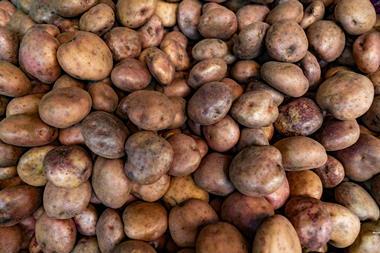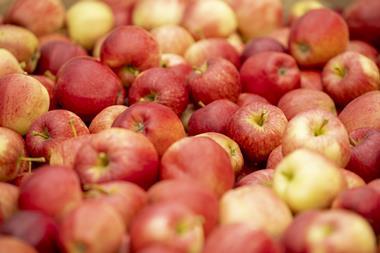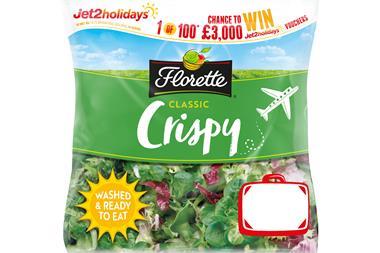Cameo, a trademarked bi-coloured dessert branded apple, beat 145 entries to win top prize at the National Fruit Show.
Its rise to prominence underlines how the English apple season, while still based on Cox, is embracing varieties with an international flavour. The second largest acreage is now Gala and Braeburn is rising fast. Both originally came from New Zealand. Others in the pipeline include Empire grown in the United States.
Cameo growers in Europe are continuing to see expansion to a club formed to exchange information on production techniques and storage. The variety - discovered in Washington State - is called Caudle and is a cross between Red and Golden Delicious. It is now commercially grown by some 30 producers and is marketed by Norman Collett who has 1,000 tonnes available.
It has been stocked by Sainsbury, Tesco, Somerfield, the Co-op, Budgens and Booths.
Other trademarked fruit is also coming over the horizon. This year Adrian Scripps is expecting to harvest more than 750 tonnes of Greenstar, a Granny Smith cross from Belgium with a bright-green smooth skin and white, crisp, juicy flesh that made its debut on the Tesco stand at the NFS two years ago and is sold exclusively by them.
Other new varieties are Kanzi - Swahili for "hidden treasure" - with its bright pink reddish blush, and a Gala/Braeburn cross from the same source. Volumes are expanding and 350 tonnes will be available from young trees. This could treble at full maturity.
New Zealand variety Jazz is also coming up fast. English growers have been planting trees rapidly over the past two years.
Rubens, a variety that was first raised in the Netherlands in the 1950s, is on trial in Kent. And niche varieties such as Delbard Estival, Tentation, Meridian and Scrumptious are now on shelves.
Its rise to prominence underlines how the English apple season, while still based on Cox, is embracing varieties with an international flavour. The second largest acreage is now Gala and Braeburn is rising fast. Both originally came from New Zealand. Others in the pipeline include Empire grown in the United States.
Cameo growers in Europe are continuing to see expansion to a club formed to exchange information on production techniques and storage. The variety - discovered in Washington State - is called Caudle and is a cross between Red and Golden Delicious. It is now commercially grown by some 30 producers and is marketed by Norman Collett who has 1,000 tonnes available.
It has been stocked by Sainsbury, Tesco, Somerfield, the Co-op, Budgens and Booths.
Other trademarked fruit is also coming over the horizon. This year Adrian Scripps is expecting to harvest more than 750 tonnes of Greenstar, a Granny Smith cross from Belgium with a bright-green smooth skin and white, crisp, juicy flesh that made its debut on the Tesco stand at the NFS two years ago and is sold exclusively by them.
Other new varieties are Kanzi - Swahili for "hidden treasure" - with its bright pink reddish blush, and a Gala/Braeburn cross from the same source. Volumes are expanding and 350 tonnes will be available from young trees. This could treble at full maturity.
New Zealand variety Jazz is also coming up fast. English growers have been planting trees rapidly over the past two years.
Rubens, a variety that was first raised in the Netherlands in the 1950s, is on trial in Kent. And niche varieties such as Delbard Estival, Tentation, Meridian and Scrumptious are now on shelves.









No comments yet